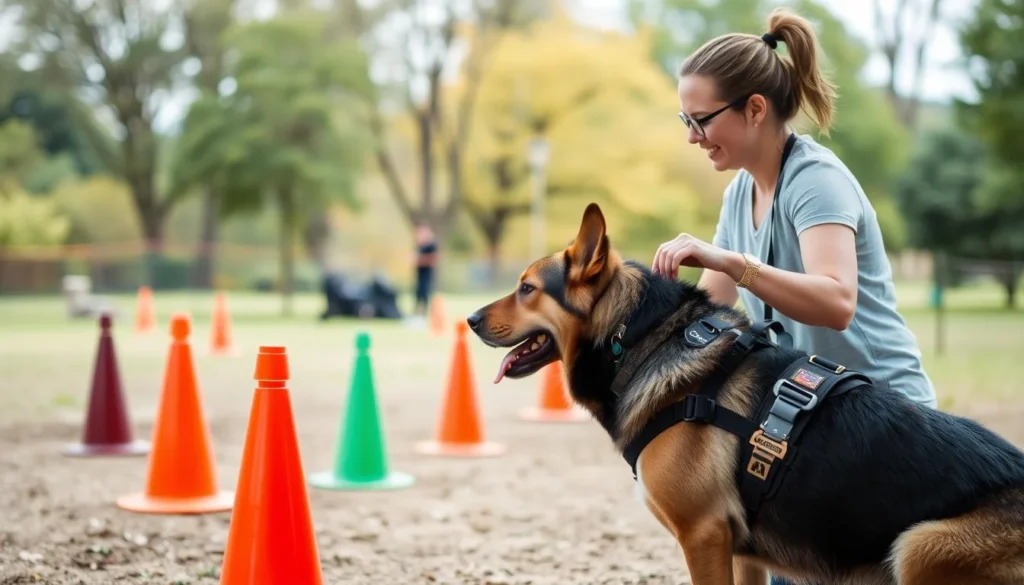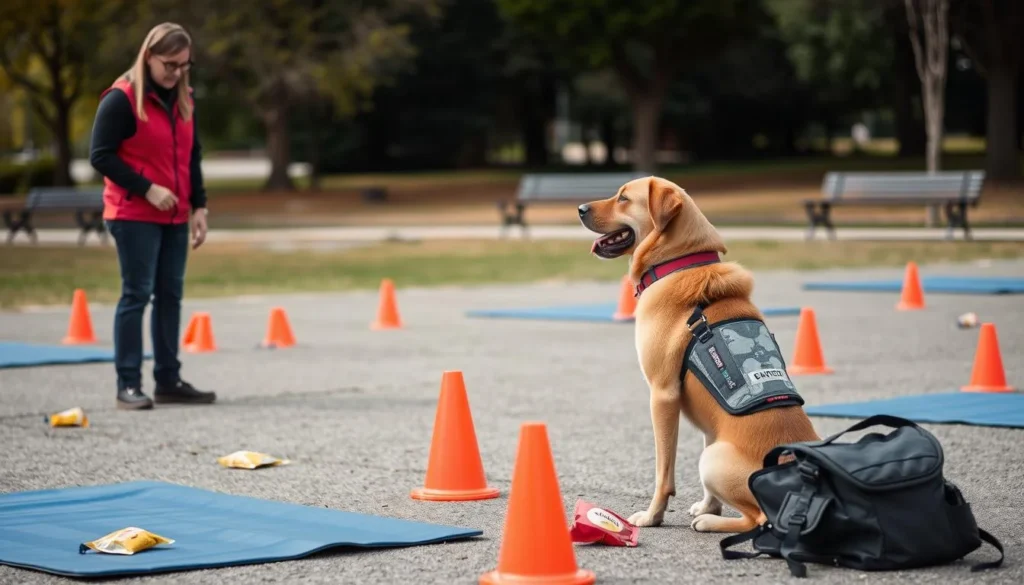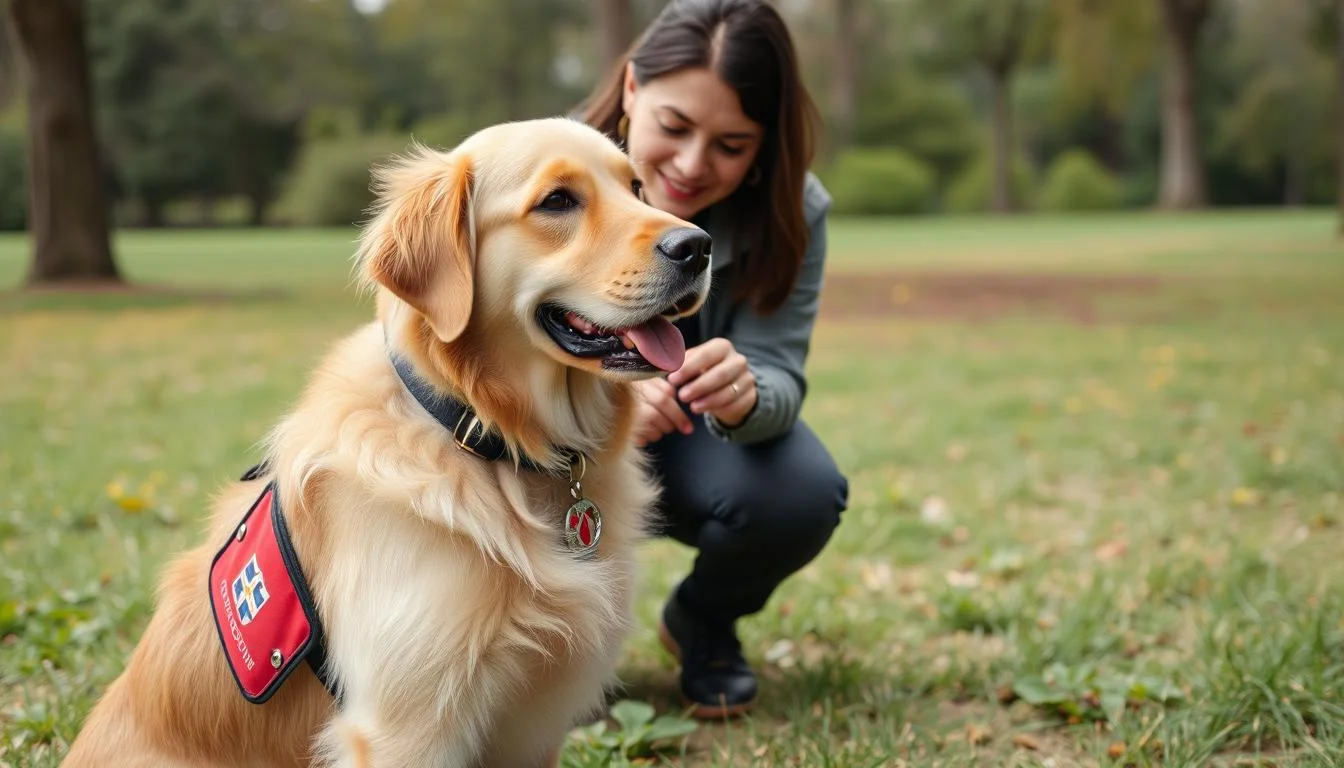Table of Contents
Service dog training is a journey that changes lives. It helps people with disabilities become more independent. Dogs learn to do complex tasks that make a big difference in their handler’s life.
Service dogs help with many conditions. This includes autism, mobility issues, seizures, and more. The training takes about 24 months to create a strong bond between dog and handler.
Training a service dog is more than just basic commands. It needs a lot of time, special techniques, and understanding both dogs and humans. Your dog will learn skills that really help in everyday life.
Key Takeaways
- Service dog training takes approximately 24 months to complete
- Dogs can be trained to support multiple disability types
- Specialized training includes advanced obedience and task-specific skills
- Positive reinforcement is key in service dog development
- Each dog-handler team is unique and needs personalized training
Understanding Service Dog Fundamentals
Service dogs are vital for people with disabilities. They offer life-changing help through special training. These dogs provide independence and support to those facing challenges.

The Americans with Disabilities Act (ADA) defines service dogs. They are animals trained to help people with disabilities. Knowing about disability support dogs means understanding their special traits and legal rights.
CLICK HERE TO UNLOCK THE SECRETS OF PERFECT DOG TRAINING
Types of Service Dogs and Their Roles
- Guide dogs for visually impaired individuals
- Hearing assistance dogs for deaf or hard-of-hearing people
- Mobility support dogs helping with physical tasks
- Seizure alert dogs for epilepsy patients
- Psychiatric service dogs for mental health support
Legal Rights and ADA Requirements
Service dogs have special legal protections under the ADA. Businesses can only ask two questions:
- Is the dog required because of a disability?
- What specific task has the dog been trained to perform?
Differences Between Service, Therapy, and Emotional Support Dogs
| Dog Type | Public Access | Training Level | Primary Purpose |
|---|---|---|---|
| Service Dogs | Full public access | Extensive task-specific training | Assist with disability-related tasks |
| Therapy Dogs | Limited access | Basic behavioral training | Provide emotional comfort in specific settings |
| Emotional Support Dogs | Minimal access | Basic training | Provide emotional comfort to owner |
“A service dog is not just a pet, but a lifeline of independence and support for individuals with disabilities.” – Disability Support Network
Successful service dogs need rigorous training and understanding of their handler’s needs. Becoming a service dog is a complex journey. It demands special skills and dedication.
Service Dog Training: Essential Requirements and Prerequisites

Starting guide dog instruction needs careful planning and knowing the service dog world well. Not every dog can be a service animal. The first step is to check if your dog has the right stuff.
CLICK HERE TO UNLOCK THE SECRETS OF PERFECT DOG TRAINING
Important things for service dog training include:
- Age between 2-4 years old
- Stable temperament with minimal aggression
- Strong foundational obedience skills
- Good physical health and genetic background
“Service dog training is 90% standard dog training and 10% public access knowledge” – Canine Training Experts
When picking a service dog, look at these important points:
| Criteria | Assessment Details |
|---|---|
| Temperament | Calm, focused, non-reactive to distractions |
| Health | No genetic predispositions to serious medical conditions |
| Trainability | Quick learning, high motivation, strong human bond |
The Americans with Disabilities Act (ADA) doesn’t require specific certification for service dogs. Your main goal should be to train your dog well for real-world tasks.
Good service dog training needs commitment, patience, and knowing about dog behavior and disability needs.
Evaluating Your Dog’s Service Work Potential
Choosing the right dog for service work is a big decision. It needs careful thought and understanding of key traits. Not every dog is right for this important job.
Starting your journey in therapy dog education and psychiatric service animal preparation means evaluating your dog’s abilities. This process looks at many important factors. These factors help decide if a dog is good for service work.
Temperament Assessment Criteria
Service dogs have certain personality traits that make them stand out:
- Exceptional emotional stability
- Low reactivity to environmental stimuli
- High focus and trainability
- Calm demeanor in diverse settings
- Strong desire to work and please
Breed-Specific Considerations
While breed is important, individual temperament is key. Some breeds are naturally better suited for service work:
| Breed | Service Strengths |
|---|---|
| Labrador Retriever | Versatile, intelligent, gentle temperament |
| Golden Retriever | Empathetic, patient, excellent for emotional support |
| German Shepherd | Protective, highly trainable, strong work ethic |
Health and Age Requirements
Your dog’s health is very important for service work. Experts usually suggest:
- Minimum age of 18 months for public access testing
- Complete medical evaluation
- Proof of basic health screenings
- Neutered/spayed status
“The right service dog is not just about breed or training, but about the unique bond between handler and animal.” – Service Dog Training Expert
Remember, preparing a psychiatric service animal takes time, effort, and understanding your dog’s unique abilities.
CLICK HERE TO UNLOCK THE SECRETS OF PERFECT DOG TRAINING
Core Training Methods and Positive Reinforcement Techniques
Training service dogs, like mobility assistance canines and diabetic alert dogs, needs a special approach. It’s all about building trust and making sure they perform well. Positive reinforcement is the best method today, making training fun and rewarding for both dog and handler.
“The key to successful dog training is understanding motivation and building a strong emotional connection”
Effective training uses several key strategies:
- Immediate rewards for good behavior
- Clear communication and expectations
- Slowly adding new skills
- A calm and structured learning space
Clicker training is a great tool for teaching diabetic alert dogs. It helps dogs know exactly what they’re doing right. This clear system makes learning faster and helps dogs master complex tasks.
Positive reinforcement is all about:
- Breaking tasks into smaller steps
- Using tasty treats to motivate
- Keeping training sessions short and fun
- Celebrating small victories
Successful service dogs are trained patiently and systematically. They learn at their own pace, respecting their unique abilities.
Basic Obedience to Advanced Task Training
Service dog training is a journey that turns a regular dog into a special helper. It needs dedication, patience, and a step-by-step approach.
Training a service dog involves several key steps. These steps help your dog get ready for important work. Most dogs need about 200-300 hours of training to learn the basics.
Foundation Commands and Skills
Every service dog needs a strong foundation of obedience. Important skills include:
- Consistent recall
- Reliable sit and stay commands
- Walking calmly on leash
- Ignoring distractions
- Responding to handler’s subtle cues
Task-Specific Training Progression
After learning basic obedience, training focuses on specific tasks. The steps are:
- Identifying specific handler needs
- Breaking down complex tasks into manageable steps
- Gradually building task complexity
- Reinforcing learned behaviors
“Training a service dog is about creating a partnership of trust and capability.” – Professional Service Dog Trainer
Public Access Training Requirements
Public access training helps your service dog work well in different places. This important part teaches dogs to stay focused and calm in tough situations.
| Training Stage | Average Hours | Key Focus |
|---|---|---|
| Basic Obedience | 100-150 hours | Core commands and behavior |
| Task-Specific Training | 120-150 hours | Disability-related assistance skills |
| Public Access Training | 50-100 hours | Environmental adaptation |
Knowing that only 50-60% of dogs finish service dog training shows how important it is. It needs careful, patient, and strategic training.
Specialized Training for Different Disabilities
Service dogs are vital for people with many disabilities. They get special training to become life-changing disability support dogs.
Each disability needs its own training approach. This ensures the service dogs can help as much as possible. The Americans with Disabilities Act sees service dogs as trained helpers for many challenges.
- PTSD Support: Dogs learn to recognize anxiety triggers and provide grounding techniques
- Mobility Assistance: Training includes retrieving items, opening doors, and providing physical support
- Medical Alert: Specialized training for seizure detection and diabetic blood sugar monitoring
- Autism Support: Dogs help reduce sensory overload and provide emotional regulation
The training is very detailed and tailored to each dog. Trainers check if the dog can do the tasks needed for different disabilities. They use positive methods to teach the dogs.
“A well-trained service dog isn’t just an animal—it’s a lifeline of independence and support.” – Service Dog Training Professional
The training time for your service dog depends on the disability. Some dogs might train for up to 12 months. They learn complex tasks and how to act in public.
Certification Process and Public Access Testing
Getting your service dog certified takes a lot of prep and knowing the testing rules. The Americans with Disabilities Act (ADA) doesn’t require a formal certification. But, many groups suggest doing public access tests to check if your dog is up to par.
Guide dog training is tough. It checks if your dog is ready for public places. Most programs say you need about 120 hours of training before the Public Access Test (PAT).
Required Documentation
To get your service dog certified, you’ll need some important papers:
- Comprehensive health records
- Training logs and progress reports
- Veterinary health clearance
- Proof of core obedience training
Testing Standards and Protocols
The Public Access Test checks your dog’s skills in different situations. You need at least 80% of the tasks done well to pass.
| Test Module | Evaluation Criteria |
|---|---|
| Vehicle Control | Calm entry/exit, controlled behavior |
| Public Interaction | Ignoring distractions, maintaining focus |
| Command Reliability | Consistent response to basic commands |
Maintaining Certification
Service dog certification isn’t forever. Continuous training and periodic re-evaluation are key to keeping your dog’s skills sharp.
“A well-trained service dog is a partnership built on trust, consistency, and ongoing learning.” – Professional Service Dog Trainer
Creating a Strong Handler-Dog Partnership
Building a strong bond between a handler and a service dog takes dedication and understanding. It’s not just about basic training. It’s about creating a deep, trusting relationship that makes them a seamless team.
- Establishing clear communication patterns
- Creating consistent training routines
- Developing mutual trust and respect
- Understanding each other’s non-verbal cues
“A service dog is not just a trained animal, but a partner who understands and supports you in every challenging moment.”
Studies show that 50% of training success comes from positive reinforcement. Your interactions should reward good behavior right away. This strengthens your bond. Consistency is key in psychiatric service animal preparation.
Here are ways to improve your handler-dog relationship:
- Spend quality time together outside training sessions
- Practice commands in various environments
- Learn to read your dog’s subtle communication signals
- Maintain a calm, patient demeanor during training
Remember, 70% of service dog candidates are dropped during training. This shows how vital a strong partnership is. Your dedication to understanding and supporting your service dog is what will make your partnership successful.
CLICK HERE TO UNLOCK THE SECRETS OF PERFECT DOG TRAINING
Conclusion
Training a service dog is a big commitment that changes lives. It’s not just about getting a pet; it’s about getting a partner. Whether you need a dog for mobility or diabetes alerts, the journey is tough.
Only 50-60% of dogs finish their service training. Success comes from knowing how to train a service dog. It starts with socialization and goes to advanced tasks.
For dogs that help with mobility, the training is long. It takes 200-300 hours of hard work. This includes basic obedience and learning to go out in public.
Getting help from professionals is key. Training a service dog can cost between $15,000 and $40,000. But the benefits are huge. A diabetic alert dog can detect health issues with up to 90% accuracy.
Every service dog is different. Your bond will grow with training, vet visits, and understanding each other. The goal is to have a dog that can help you confidently in the world.
